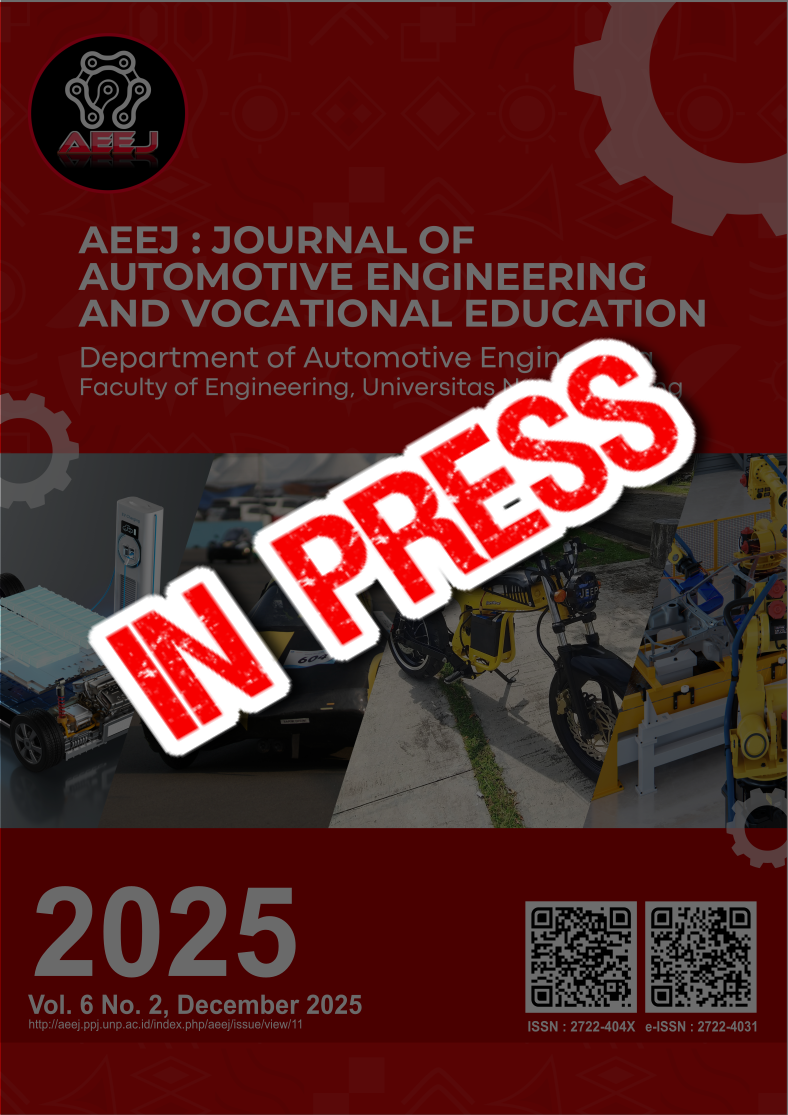Analysis the Effect of Variation Permanent Magnet and Winding on BLDC Motor Performance Using ANSYS Maxwell Simulation
##plugins.themes.academic_pro.article.main##
Abstract
One of the driving components of electric vehicles that are often used is Brushless (BLDC) motors which have advantages such as high efficiency, large torque density, and precise speed control. This study aims to evaluate the effect of variations in permanent magnet type and stator winding configuration on the performance of Brushless DC (BLDC) motors. Two types of permanent magnets, NdFe35 and SmCo24, are compared based on their electromagnetic characteristics, such as torque, rotational speed, efficiency, and current consumption. In additional, the stator winding parameters were varied, including wire diameters between 1.3 mm and 1.6 mm and the number of conductors per slot between 14 and 23. The simulation results conducted using ANSYS Maxwell show that the configuration combining NdFe35, an optimal number of 14 conductors per slot, and a large wire diameter of 1.6 mm delivers the best performance, with a maximum torque of 325 Nm, maximum power of 2.91 kW, efficiency of 79%, and a speed of 1241.5 rpm. Although the current consumption is high, the resulting power and torque performance are proportional.
##plugins.themes.academic_pro.article.details##

This work is licensed under a Creative Commons Attribution 4.0 International License.
References
[2] H. El Hadraoui, M. Zegrari, A. Chebak, O. Laayati, and N. Guennouni, “A Multi-Criteria Analysis and Trends of Electric Motors for Electric Vehicles,” World Electric Vehicle Journal, vol. 13, no. 4, pp. 1–28, 2022, doi: 10.3390/wevj13040065.
[3] D. Mohanraj et al., “A Review of BLDC Motor: State of Art, Advanced Control Techniques, and Applications,” IEEE Access, vol. 10, pp. 54833–54869, 2022, doi: 10.1109/ACCESS.2022.3175011.
[4] R. Kurniawan, E. A. Hakim, and M. Irfan, “Analisis Pengaruh Variasi Lebar Air Gap Pada Motor Brushless DC Radial Fluks,” Journal of Mechatronic and Electrical Enggineering, vol. 1, no. 1, pp. 1–7, 2021, [Online]. Available: https://ejournal.umm.ac.id/index.php/JMEE/article/view/11830%0Ahttps://ejournal.umm.ac.id/index.php/JMEE/article/download/11830/9637
[5] Y. ÖZÜPAK, “Design and Analysis of Permanent Magnet DC Machines with FEM Based ANSYS-MAXWELL,” International Journal of Innovative Engineering Applications, vol. 7, no. 1, pp. 7–12, 2023, doi: 10.46460/ijiea.1130422.
[6] T. Subramani et al., “Effect of Nano Urea on growth, yield and nutrient use efficiency of Okra under tropical island ecosystem,” International Journal of Agricultural Sciences, vol. 19, no. RAAAHSTSE, pp. 134–139, 2023, doi: 10.15740/has/ijas/19.raaahstse-2023/134-139.
[7] F. Ferdyanto, G. Fatwa, A. Erlangga, and I. Marbawi, “Performance Analysis of Permanent Magnet BLDC Motor for Reducing Cogging Torque Using Taguchi Method,” Elkha, vol. 16, no. 1, p. 28, 2024, doi: 10.26418/elkha.v16i1.76582.
[8] S. H. Susilo et al., “STUDY OF STATOR SLOT CONFIGURATION AND COIL DIAMETER ON BLDC MOTOR,” vol. 1, no. 1, pp. 15–20, 2025, doi: 10.15587/2706-5448.2025.323779.
[9] Y. L. Karnavas, I. D. Chasiotis, and A. D. Gkiokas, “An Investigation Study Considering the Effect of Magnet Type, Slot Type and Pole-Arc to Pole-Pitch Ratio Variation on PM Brushless DC Motor Design,” Proceedings - 2018 5th International Conference on Mathematics and Computers in Sciences and Industry, MCSI 2018, pp. 7–13, 2018, doi: 10.1109/MCSI.2018.00010.
[10] J. Hao, S. Suo, Y. Yang, Y. Wang, and W. Wang, “Investigation on the relationship between winding wire size and total loss of BLDC,” J Phys Conf Ser, vol. 1187, no. 2, 2019, doi: 10.1088/1742-6596/1187/2/022032.
[11] A. Sauky et al., “Jurnal Sauky Terbit,” vol. 10, no. 2, pp. 2–4, 2021.
[12] Ansys, “Maxwell Help,” © ANSYS, Inc., no. January, p. 2955, 2019.
[13] C. F. Yuliyanto and Asrori, “Pengaruh Jumlah Slot Stator Terhadap Kecepatan Putaran dan Suhu pada Motor BLDC,” Journal of Mechanical Engineering, vol. 1, no. 3, p. 11, 2024, doi: 10.47134/jme.v1i3.2962.
[14] E. Cetin, “Brushless Direct Current Motor Design and Analysis,” COJ Electronics & Communications, vol. 2, no. 2, pp. 1–13, 2021, doi: 10.31031/cojec.2020.02.000534.
[15] C. Rachael, G. Adam, and S. Andrewson, “Overview of Brushless DC ( BLDC ) Motors and Their Advantages Author,” no. April, 2025.
[16] A. Sen, B. Singh, K. Mahtani, A. Moradzadeh, and S. M. Muyeen, “Results in Engineering Optimized design of a permanent magnet brushless DC motor for solar water-pumping applications,” vol. 26, no. November 2024, 2025.
[17] C. Zhu, R. Lu, C. Mei, T. Peng, G. Zhang, and F. Aymen, “Design and Simulation Analysis of Stator Slots for Small Power Permanent Magnet Brushless DC Motors,” International Transactions on Electrical Energy Systems, vol. 2023, 2023, doi: 10.1155/2023/1152243.
[18] A. Kumar, R. Gandhi, R. Wilson, and R. Roy, “The impact of different slot design of BLDC motor in a complete drive system,” IECON Proceedings (Industrial Electronics Conference), vol. 2020-Octob, pp. 4300–4305, 2020, doi: 10.1109/IECON43393.2020.9255391.
[19] M. S. Raja and B. Geethalakshmi, “Modified Rotor Material for Minimization of Torque Ripple for Interior Permanent Magnet BLDC motor,” Mater Today Proc, vol. 5, no. 2, pp. 3639–3647, 2018, doi: 10.1016/j.matpr.2017.11.614.
[20] Ing. Jan Hlúbik, “Czech Technical University in Prague Faculty of Electrical Engineering Department of Cybernetics,” no. September, p. 49, 2005, doi: 10.13140/RG.2.1.2601.1764.
[21] L. Knypiński, A. V. Reddy, B. Venkateswararao, and R. Devarapalli, “Optimal design of brushless DC motor for electromobility propulsion applications using Taguchi method,” Journal of Electrical Engineering, vol. 74, no. 2, pp. 116–121, 2023, doi: 10.2478/jee-2023-0015.

